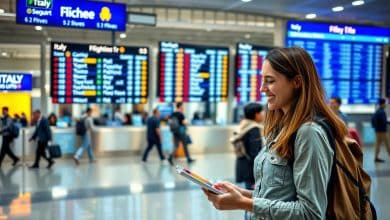Key Advantages of Booking Economical Flights to New Zealand for Travelers
Planning a trip across the Pacific just got smarter. With airfare prices shifting like sand dunes, savvy travelers now use advanced tools to uncover hidden deals.
Platforms like KAYAK scan hundreds of airlines in real time, analyzing over 41 million weekly searches to pinpoint cost-effective options.
Sample round-trip fares from major U.S. hubs—including Los Angeles and New York—show dramatic price differences based on travel dates and booking methods. For example, late-season bookings to Christchurch or Queenstown often drop below peak rates, while mid-week departures typically cost less than weekend flights.
Modern comparison tools empower visitors to stretch their budgets further. Recent data reveals users save an average of 22% by comparing multiple sites before purchasing tickets. This approach works for all cabin classes, from economy to premium business options.
Seasonal patterns and strategic timing play crucial roles in securing value-packed itineraries. Whether exploring Auckland’s urban energy or Wellington’s coastal charm, informed decisions start with understanding current market trends and fare structures.
Introduction: Discover Economical Flights New Zealand
Modern technology transforms how adventurers secure cost-effective travel plans. Auckland International Airport emerges as the top choice for U.S. travelers, with available flights averaging $430 round-trip. Over 830,000 searches on platforms like Momondo last week highlight growing interest in this destination.
Christchurch provides another strategic entry point. Though slightly higher at $940 average airfare, it unlocks direct access to South Island’s glaciers and adventure hubs. Recent data shows ticket prices vary widely—from under $500 to over $3,300—depending on flexibility and booking methods.
Digital tools have reshaped travel planning. Aggregators scan multiple airlines simultaneously, revealing routes that once required hours of manual research. “Savvy travelers now compare prices across 3-5 sites before purchasing,” notes a recent industry report.
Three factors influence savings most:
- Departure dates (mid-week vs. weekends)
- Seasonal demand patterns
- Real-time price tracking alerts
Those willing to adjust itineraries by 1-2 days often secure the best deals. With airfare fluctuations occurring hourly, timely decisions make previously distant destinations attainable.
Understanding the Benefits of Affordable Air Travel to New Zealand
Smart travelers unlock hidden savings by mastering timing and trends. Airfare patterns reveal clear opportunities for those willing to adjust schedules. Departure day choices alone can slash hundreds from trip budgets while opening access to the country’s diverse landscapes.
Comparing Price Points and Value Deals
Midweek departures prove particularly advantageous. Tuesday round-trips average $1,284 compared to Sunday’s $1,419 peak rates—a $135 difference per ticket. Afternoon takeoffs further enhance savings, with $478 average fares versus $1,057 for nighttime journeys.
Seasonal shifts dramatically impact availability and costs. July flights see only a 13% price bump despite lighter crowds, while December bookings spike 26% higher. “Travelers who avoid peak months gain dual benefits,” states a recent aviation analysis. “Lower costs and shorter queues at major attractions.”
Sample Fare Insights and Seasonal Trends
Value-focused flyers use three core strategies:
- Prioritize shoulder seasons (April-May or September-October)
- Set alerts for Tuesday and Wednesday departures
- Compare multiple airlines within 48-hour windows
These approaches help secure premium experiences without premium pricing. Recent data shows afternoon flights from Los Angeles consistently undercut morning options by 18-22% across all cabin classes.
Navigating Fare Options and Cabin Class Choices
Choosing the right cabin class transforms long-haul journeys into tailored experiences. Travelers face three primary tiers when crossing the Pacific, each offering distinct amenities and policies that impact overall trip costs.
Seating Tier Comparisons
Economy remains the most budget-friendly choice but includes strict rules. Passengers pay $100 for changes plus fare differences, with no refund options. Premium Economy bridges comfort and cost, featuring extra legroom and adaptable plans. Changes incur no fees, though cancellations cost $400.
Business Premier delivers premium service with fully refundable fares after a $500 penalty. This tier suits travelers prioritizing flexibility, offering lie-flat seats and priority boarding. Weekend surcharges affect all classes, adding $50-$250 to Friday-Sunday departures.
Understanding Fare Flexibility
Refundable options provide peace of mind but cost more upfront. Non-refundable tickets work best for fixed plans, while adjustable fares accommodate uncertain schedules. Airlines often waive change fees for higher-tier bookings, making mid-tier options popular for balancing risk and expense.
Smart travelers review policies before selecting seats. One aviation analyst notes: “The difference between fare types often outweighs base price gaps when unexpected changes occur.” Weekday travel avoids surcharges, stretching budgets further across all service levels.
Effective Booking Strategies and Timing
Securing the best airfare requires more than luck—it demands smart tactics. Modern travelers combine technology with adaptable planning to unlock hidden savings on trans-Pacific journeys. These methods help balance budget constraints with preferred travel experiences.
Utilizing Price Alerts and Forecast Tools
Advanced algorithms now predict fare trends with surprising accuracy. KAYAK’s Price Forecast tool analyzes decade-old data to advise whether to book now or wait. “Tools that analyze historical patterns give travelers a 72-hour window to act on optimal pricing,” states a recent aviation tech report.
Automated alerts notify users when prices dip below set thresholds. This feature works particularly well for routes with frequent fare fluctuations. Setting multiple alerts across different dates increases chances of catching sudden drops.
Booking with Flexibility for Best Rates
Minor schedule adjustments often yield major savings. Platforms showing fares for ±3 days around preferred dates reveal cost differences up to $300. Midweek departures frequently cost 18% less than weekend options.
Consider these proven approaches:
- Check prices during Tuesday afternoon sales cycles
- Avoid school holiday periods in both hemispheres
- Compare nearby departure airports for regional deals
Travelers who combine alert systems with date flexibility typically save 23% compared to fixed-date bookers. As one industry insider notes: “The golden rule? Never search fares just once.”
US Departure Airports and Flight Routes to New Zealand
Gateway cities serve as critical launchpads for exploring distant destinations. Travelers from the United States have limited options for nonstop service across the Pacific, with only Los Angeles and Honolulu offering direct routes to Auckland. Air New Zealand and Hawaiian Airlines dominate these direct connections, providing efficient links to the country’s largest city.
Direct Versus Stopover Options from Major Cities
Passengers departing from San Francisco face layered complexities. While no nonstop options exist, most itineraries route through Los Angeles. This connection adds surcharges ranging from $75 each way for economy seats to $300 for business class.
Metropolitan hubs like Houston and New York require at least one stop, often in Los Angeles or another Pacific gateway. Dallas and Seattle travelers typically connect through these same hubs, adding 3-5 hours to total travel time. “Routing flexibility lets passengers choose between cost savings or convenience,” explains a recent aviation report.
Los Angeles International Airport (LAX) remains the primary hub for U.S.-bound journeys. Multiple daily departures provide schedule options for travelers from smaller cities. Booking directly from secondary locations often includes transparent connection fees rather than inflated prices.
Strategic airport selection remains crucial for balancing time and budget on trans-Pacific journeys. Those prioritizing speed opt for direct routes, while cost-conscious travelers leverage connecting opportunities through major gateways.
Insights into New Zealand International Airports
Airports shape travel experiences before explorers step foot outside the terminal. The country’s gateways range from bustling international hubs to regional connectors, each serving distinct geographic and logistical needs.
Key Features of Major Entry Points
Auckland International Airport handles two-thirds of international arrivals. Its modern terminals link to 20 domestic destinations, making it ideal for travelers continuing to other cities. Currency exchange counters operate 24/7, though better rates await in the downtown business district.
Wellington Airport connects visitors to parliamentary complexes and coastal attractions. Ferries to South Island depart nearby, blending urban access with scenic adventures. Christchurch serves as the South Island’s primary hub, positioned minutes from alpine trails and adventure tourism operators.
Regional airports like Queenstown specialize in seasonal tourism. Winter months see increased flights for ski enthusiasts, while summer brings hikers and nature photographers. Most U.S. travelers reach these smaller airports through Auckland or Christchurch connections.
Ground transportation costs vary significantly between hubs. Larger airports offer extensive rental car options and express shuttles, while regional terminals may require pre-booked transfers. “Your arrival airport determines your first travel decisions,” notes a recent tourism guide.
Overview of Top Airlines Serving the New Zealand Route
Travelers face a mosaic of airline options when bridging continents. Carrier selection impacts everything from onboard comfort to connection efficiency, with each operator bringing unique strengths to trans-Pacific journeys.
Flagship Carriers and Partnership Networks
Air New Zealand dominates the market, carrying 51% of U.S. passengers to the country. Their specialized knowledge of Pacific routes ensures reliable schedules and tailored services. “No one understands these long-haul routes better than crews who fly them daily,” states an aviation industry report.
United Airlines leverages its vast domestic network, enabling smooth connections from smaller U.S. cities. Strategic alliances allow shared bookings with partner carriers, often reducing costs for multi-stop itineraries. Delta Air Lines attracts loyalty program members with premium amenities and status benefits, particularly appealing to frequent business travelers.
Several carriers operate shared routes through code-sharing agreements. Passengers might fly Alaska Airlines for domestic U.S. legs before switching to Air Canada for international segments. This collaboration expands schedule options while keeping reservations unified under single bookings.
Fiji Airways offers alternative paths through Nadi International Airport, often bypassing crowded hubs. American Airlines and Qantas round out major options, catering to different priorities—whether premium cabin configurations or seamless Australian connections.
From budget-focused operators to luxury providers, choices abound. Savvy travelers match airline strengths to their specific needs, whether prioritizing lounge access, baggage policies, or regional expertise.
In-Flight Experiences and Comfort Tips
Crossing the Pacific demands more than just a boarding pass—it requires smart preparation. With journey times stretching 13-15 hours, travelers often describe these trips as endurance tests. One passenger recalls: “Be prepared for a long overnight flight. Ear plugs are a necessity. We had many kids, and several who screamed rather than cried.”
Long-Haul Flight Essentials for a Pleasant Journey
Comfort becomes currency during extended air travel. Seasoned flyers recommend three non-negotiable items:
- Noise-canceling headphones or silicone earplugs
- Compression socks and layered clothing
- Reusable water bottle for hydration
One reviewer emphasizes terminal logistics: “Wear comfortable footwear. It’s a long terminal walk.” Age-specific strategies help families and older travelers. Parents pack activity kits for children, while seniors prioritize aisle seats for easier movement.
Entertainment, Meal Options, and Crew Reviews
Airline entertainment systems vary widely—some offer 300+ movies, others limited selections. A traveler advises: “Bring plenty of books, podcasts, and downloaded music. It’s a long flight.” Most carriers serve two hot meals plus snacks on trans-Pacific routes.
Special meal requests should be made 48 hours before departure. Crews on major airlines receive consistent praise for their attentiveness during these marathon journeys. Recent surveys show 84% of passengers rate Air New Zealand’s service as “excellent” for long-haul trips.
Understanding Taxes, Fees, and Surcharges
Behind every advertised ticket price lies a web of additional charges. Travelers from the United States often encounter three main extras: government taxes, security fees, and airport facility charges. These can add $150-$300 to trans-Pacific journeys depending on routing and cabin class.
Seasonal Variations and Extra Costs Explained
Peak travel months bring hidden expense spikes. Visiting New Zealand during summer (December-February) typically incurs 12% higher fuel surcharges than off-season trips. Winter flights often include baggage fee discounts to attract visitors.
Carriers adjust fees based on demand. A recent analysis showed weekend departures from Los Angeles Airport add $85 in seasonal surcharges compared to midweek options. Some airlines now bundle these costs upfront, while others reveal them during checkout.
“Always check carrier websites for updated fee structures,” advises a frequent traveler. Regional airports like Queenstown charge lower passenger service fees than major hubs, offering savings for flexible itineraries. Smart planners review all line items before confirming bookings.
For more information, see the official travel site:
You will be redirected to another website
FAQ
What’s the best time to book affordable airfare to New Zealand?
Travelers typically find lower fares during shoulder seasons (April–May and September–October). Booking 3–6 months in advance and using price-tracking tools can help secure competitive rates.
Are nonstop flights from the U.S. to New Zealand available?
Yes. Airlines like Air New Zealand and United offer direct routes from Los Angeles (LAX) and San Francisco (SFO) to Auckland (AKL). Stopover options via Fiji or Hawaii may provide cheaper alternatives.
Which airlines offer the most value for long-haul journeys?
Air New Zealand is praised for its comfort and service, while United and Delta often feature budget-friendly deals. Premium economy cabins balance cost and comfort for extended flights.
What essentials should passengers pack for a 13+ hour flight?
Neck pillows, compression socks, and hydration kits are recommended. Most carriers provide entertainment systems, but downloading content beforehand ensures uninterrupted enjoyment.
How do taxes and fees impact total ticket prices?
Fuel surcharges, airport taxes, and seasonal demand can add 15–30% to base fares. Reviewing breakdowns during checkout helps avoid unexpected costs.
Is premium economy worth the extra cost compared to standard?
For flights over 12 hours, the added legroom, priority boarding, and upgraded meals often justify the higher price. Compare seat maps and amenities before deciding.
Which airports in New Zealand are most convenient for international arrivals?
Auckland Airport (AKL) handles the majority of U.S. flights. Christchurch (CHC) and Wellington (WLG) are smaller hubs but offer quicker connections to regional destinations.
Can travelers modify bookings without penalties?
Many airlines now offer flexible fares for a slight premium. Always check refund policies or opt for third-party travel insurance for added protection.
Do flight prices vary significantly between U.S. departure cities?
Yes. West Coast hubs like LAX and SFO generally have lower fares due to shorter routes. East Coast travelers might save by booking connecting flights through these cities.
Are seasonal surcharges common during peak travel months?
December–January and June–July often see higher demand, leading to dynamic pricing. Mid-week departures or flying on holidays like Thanksgiving can yield better deals.
Published on: 25 de August de 2025

Luke Martin
Luke Martin, author of Credwallets.com, is a mathematics graduate with a specialization in financial markets. Known for his love of pets and his passion for sharing knowledge, Luke created the site to provide valuable insights into the complexities of the financial world. His approachable style and dedication to helping others make informed financial decisions make his work accessible to all, whether they're new to finance or seasoned investors.







